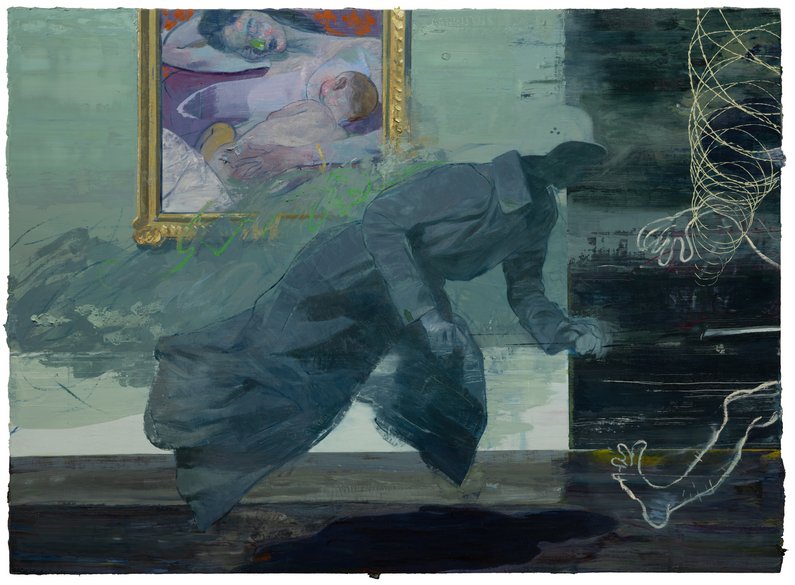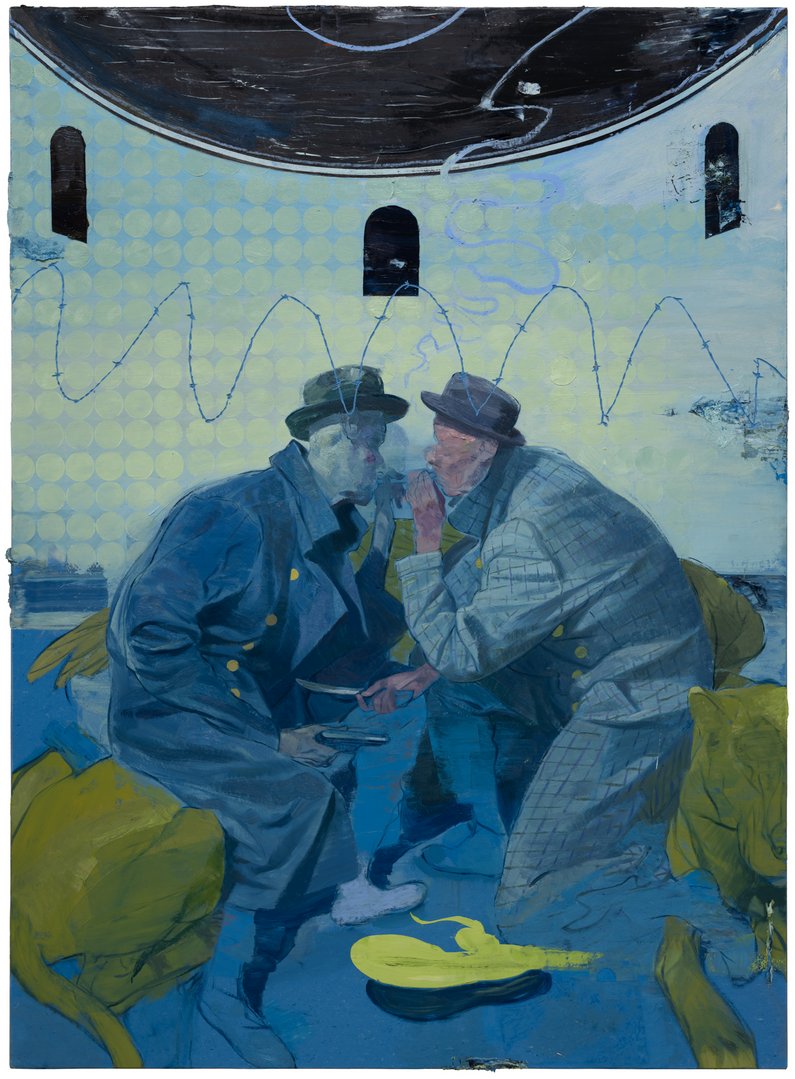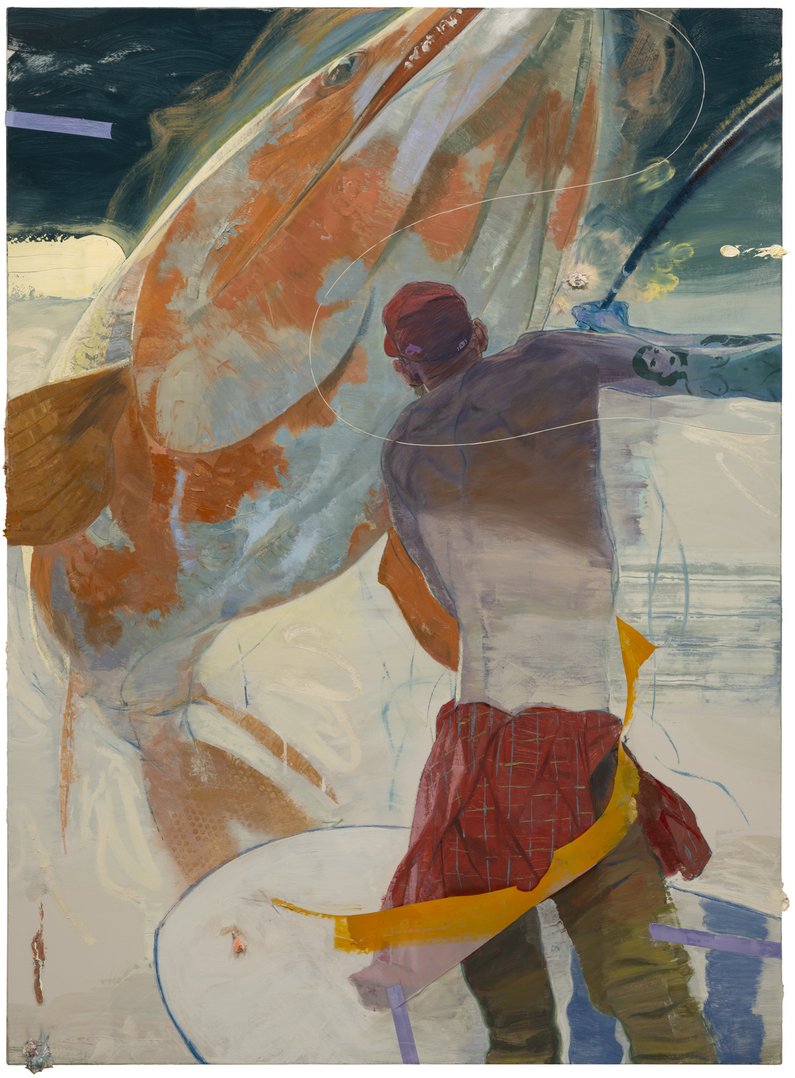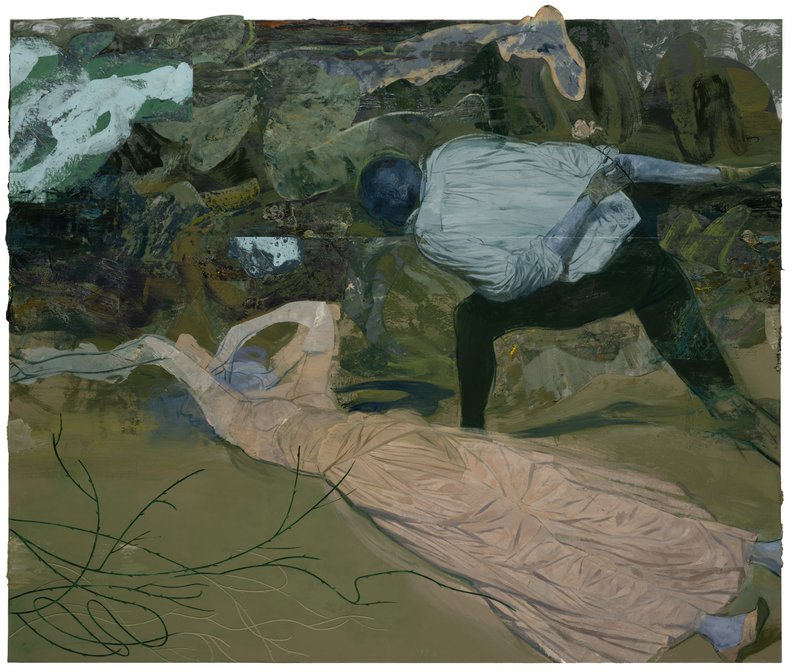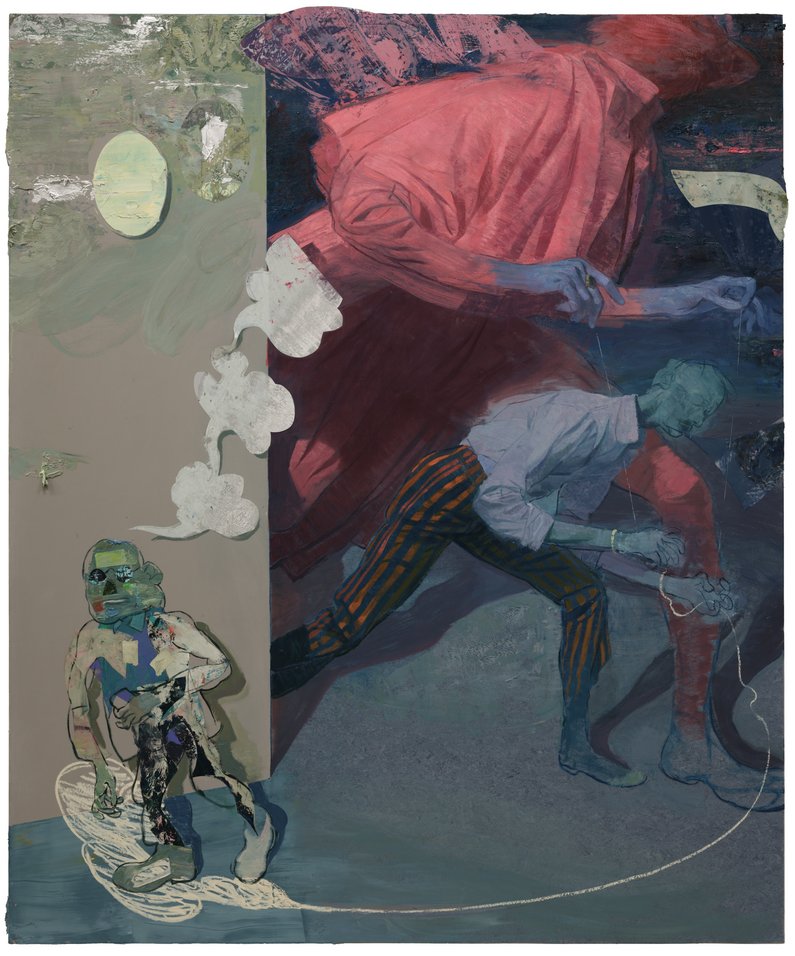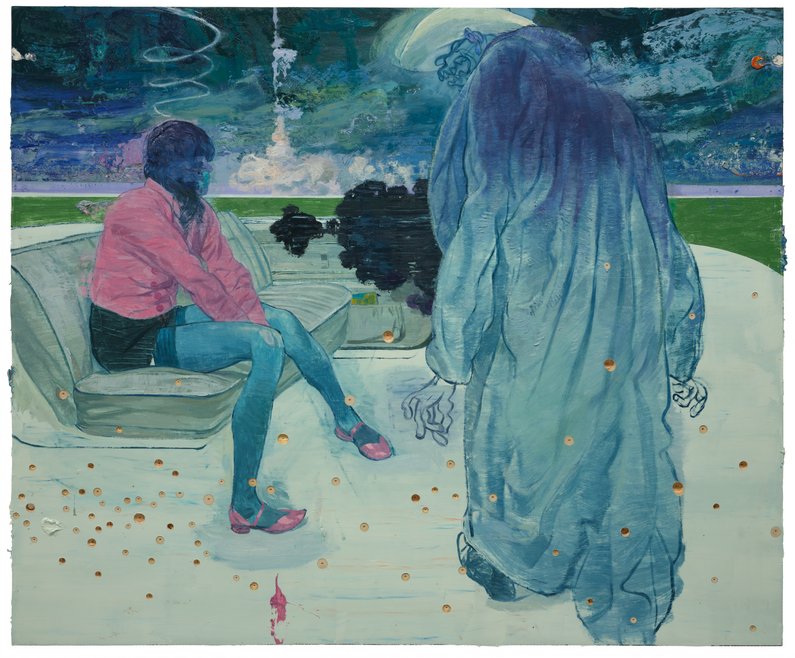FANCY FREE
The paintings of Ruprecht von Kaufmann, Text by Mark Gisbourne.
FANCY FREE
The paintings of Ruprecht von Kaufmann
Ever let the fancy roam pleasure never is at home …
John Keats ‘Fancy’ (1818–20)
It is a colloquial and poetic commonplace to claim ‘imagination is as imagination does’, for the provocative imagination is a spontaneous and at times a fickle creature. And yet it is a free and associative imagination that is at the actual core of Ruprecht von Kaufmann paintings, for his mastery of painting as a pictorial medium of facture rests in his accomplished use of sublimation. In the use of creative intuition the imagination is the act or power of forming a mental image of something not present to the senses or never before wholly perceived within reality. While painters are undoubtedly influenced and shaped by images of the past, this in no way negates the potential creative interface between a painter and his/her chosen pictorial subject today. The recent von Kaufmann paintings are executed on flat linoleum mounted on board, which gives the facility of greater ground resistance that goes beyond the pliable and sometimes uneven textured surface of canvas. At the same time it allows for material incisions into the surface ground in a manner reminiscent of relief techniques such as linocuts.
The synthesis of imagination and process must not be considered that of
random fantastical imaginings, sometimes mistakenly suggested in regard to von Kaufmann’s earlier paintings. The artist is just as interested in the strange and uncanny behavioural quandaries of the everyday, human autonomic functions and familiar habits of daily life that appear odd and paradoxical in retrospect. The artist sees no fundamental difference between figurative imagining and abstract painting as a forced distinction, and to the extent that there is fantasy, his work is a psychical collage sifted through consciousness – a deferred memorial imagining with discernable aspects that remain connected to reality. As such von Kaufmann’s contents are far removed from common fantasies associated with escapism. While they sometimes intimate allusions to memory and dreamlike reverie, they do so in regards to the artist’s feelings of phenomenal introspection. It is this introspective aspect that evokes their brooding pictorial sense, and generates the intangible qualities that in turn give each painting its unique tone. For tone in a painting is that which intuits a visual mood and prompts emotions.
The current series of paintings exhibited reveal something of a return to storytelling, yet narrative is never intended as linear or literal in the paintings of von Kaufmann. It is rather that of artist-to-viewer evoking a sense of reciprocity, where the painted elements are depicted as pictorial ciphers that must be visually decoded, and the imagined potential of the narrative reconceived in the mind of the viewer. This
does not mean they are without any referents, and a painting like the mid-size
format Rasputin’s Last Dance (2023) obviously carries a connotation of the famous
Eurasian mystic and shaman of the Russian Imperial Court, who was brutally murdered during the First World War. The seeming polar bear might also draw upon immediate Russian references. as the Rasputin figure offers the decollated head of a bird (a Romanov eagle, perhaps) to the beast. But these pictorial iconographic allusions are just as common to pop songs and even movie or dance video sources taken from popular culture. The point made is that the viewer is presented with
a palimpsest of associative imaginings, a layering of pictured historical and contemporary denotative possibilities that remain elusive and open. The elusiveness is also made evident in the artist’s use of a collage-like material facture, where the description of things depicted is often simplified and abstracted in order to become more visually allusive.
In the vertical format painting Der Fischer und Seine Frau (The Fisherman and His Wife, 2023), we immediately touch upon a fusion of imagination and reality. The apparent subject matter is feasibly at least an imaginable event, undercut by the scaled relationship of the serpentine posed fisherman and the giant ornamental ‘koi’ carp that is being landed. Like a large inflatable leaping orca the fish soars skyward as the rod bends in poised counterpoint to the curved swing of the jacket and shirt tied around the lithe fisherman’s waist. The woman tattooed on the right arm appears to be the wife referred to in the title. As a narrative it evokes a sort of ‘fisherman’s tale’ with all the witty humour that such a story supposes. Yet when the facture of the painting is seen close up, it intimates layered superimpositions of paint that express a feeling of pure abstraction. Von Kaufmann’s paint application is always both visually succulent and sensually haptic, where a feeling for the alluring tactility of the paint surface is ubiquitous. While often using a narrow range of colours that are sometimes tempered to an opaque sfumato or misty surface effect, we also find narrative introspection as in Spy vs Spy (2023) where two conversant gangster spies are depicted in compositional reversal, one with a revolver in his right hand the other similarly with a long knife. We are uncertain whether they are in a state of conspiracy or an imminent threat to one another. They two figures are dressed in film noir hats and garb of a Dashiell Hammett spy thriller of the 1940s and 50s. The curve of what appears a apsidal room with high wall niches furthers the sense of conspiratorial enclosure, and the sensation of a clandestine meeting is heightened by the barbed wire that runs like the rhythmic pulse of a heart beat across the centre field of the painting. The collaged comic aspects of the man of the right stand in contrast to fully male attired Sam Spade character on the left. As it appears in many of this current series of Ruprecht von Kaufmann’s paintings we find that mystery as much as that of an imagined projected fantasy permeates the paintings.
We might consider the artist’s love of objects that operate frequently in the interplay of detail and diffusion in his paintings, in particular as either description and/or amorphous forms of presence. In Die Vermessung der Welt (Measuring the World. 2023), the hallucinatory chandelier it set against the fabric wallpaper in the upper reaches of the painting, and stands out high above the semi-interlocking group of figures that are juxtaposed below. The descriptively detailed shoes and garment foreground right, serve a visual contrast to the somewhat amorphous content presented by the sphinx-like creature. This idea seems to touch upon observations previously made by the artist, that little of a referent object or part-object needs expression to create the potential of narrative. At the same time von Kaufmann incorporates various other possible narratives within what might at first seem a dominant line of storytelling—leaving the interpretive interplay open to a further reading of a viewer in response. In Die Vermessung der Welt the bespectacled old man tailor or cobbler figure tying his shoe in the foreground centre. is placed next to the black stocking reclining Olympia to his right. Whether this juxtaposition is left to indicate some form of post-coital liaison is not made clear. This narrative element stands in marked contrast to the shaggy and heavy booted giant depicted at the left of the painting. The clothed figures throughout however, carry layered allusions to the historical fused with imagined fancy and perhaps even to the tradition of picture book illustrations. The title makes reference to the recent 2012 film of the same title, a movie that narrated the lives and adventures of the famous 19th century German geographer-naturalists Alexander von Humboldt and the mathematician-geodesist Carl Friedrich Gauss.
The green tonal colouration of Die Vermessung der Welt is seen again in another horizontal format painting entitled Das Rotkäppchen (Little Red Riding Hood, 2023), which draws an obvious reference to the famous Brothers Grimm fairy tale. Yet there is no sign of the Red Riding Hood character in the painting, but rather an levitating apparitional figure passing across the foreground space as seen from left to right. A gold-framed painting of a painting within the painting hangs on the background wall in what is, compositionally speaking, a frieze-like setting. There is a dark wall showing rolled razor wire and a comic graffiti line chalk drawing figure silhouette appearing to enter from the right. It feels to the current author reminiscent of the famed “stuff of what dreams are made of, and our little life is rounded by a sleep …” There is an unresolved sense of mystery and immediate presentiment, a harbinger of potential disturbance. In 525 S. Winchester Boulevard (2023) we find a female figure immersed in a welter of dress drapery as object. The title references the Winchester Mystery House, located in San Jose, California. Often claimed and famed as the most haunted house in America it has been the subject of a recent mystery horror movie. The famed Sarah Winchester appears yo be elevated in the painting above a turbulent sea churning below. The beautifully executed patterned fabric details of her jacket contrast the billowing drapery within which the woman seems partially overwhelmed. The fabrics and what appear as buttons reflect the consuming clutter for which her house became duly famed. We see in this painting and intense interpolation of expression, saturated red countering the field o green dress drapery, the familiar use of detail and diffusion, of areas of description and cursory abstraction, freely doodled line drawn elements, and tempered marks of gesture. In short we see a vibrant and highly personal vocabulary of mark making. They are not paintings that are pre-determined by planned thought, but by the free flow of continuous imagination distilled through the processes of consciousness. Poet’s saw this as the creative condition of ‘fancy’, as the power of conceiving and giving artistic form to that which is not yet existent, known, or experienced in the world. The term is implicitly tied to artistic creativity and to the facilitation of ut pictura poesis – as in painting so is poetry. Mark Gisbourne
